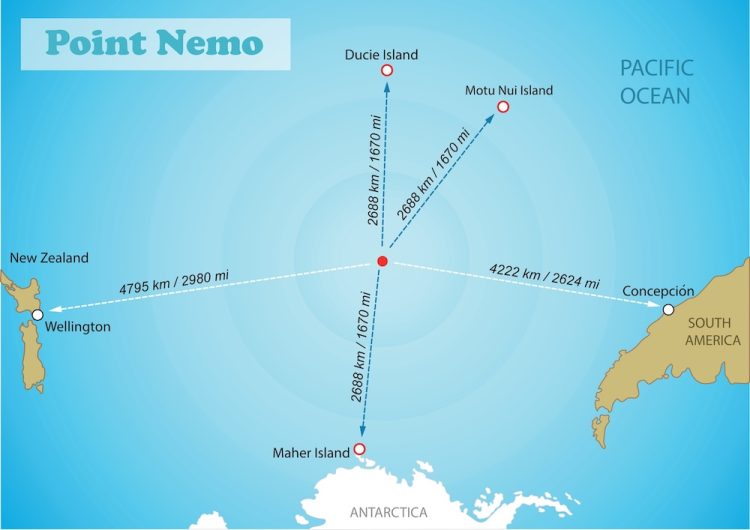Imagine being farther from dry land than anyone has ever been—so far out in the ocean that astronauts floating overhead are literally your closest neighbors. Welcome to Point Nemo, Earth’s most isolated location and quite possibly the loneliest spot on our planet.
Point Nemo isn’t just “remote.” It is mathematically, precisely, scientifically the most isolated place possible on Earth’s surface. Located at coordinates 48°52.6′S 123°23.6′W in the South Pacific, this watery wasteland sits an astounding 2,688 kilometers from the nearest speck of land in any direction.
The location represents what geographers call a “pole of inaccessibility”—essentially the center of the largest circle you could draw in the ocean without touching any coastline. It’s the solution to what researchers playfully call the “longest swim problem”: if you were unfortunate enough to fall overboard here, you’d face the longest possible journey to reach safety.
Three lonely islands mark the boundaries of this oceanic void: Ducie Island from the Pitcairn chain to the north, Motu Nui near Easter Island to the northeast, and Maher Island off Antarctica’s coast to the south. Each sits precisely the same distance away, making Point Nemo the perfect center of this triangle of desolation.
The location owes its evocative name to Croatian-Canadian engineer Hrvoje Lukatela, who “discovered” this mathematical curiosity in 1992 using his geospatial software called Hipparchus. Rather than choosing something clinical, Lukatela named his find after Captain Nemo, the enigmatic submarine commander from Jules Verne’s classic novel “Twenty Thousand Leagues Under the Sea.” The timing was perfect—this was over a decade before Pixar’s orange clownfish would claim the name for a new generation.
Here is maybe Point Nemo’s most surreal factoid: when the International Space Station passes overhead at its typical altitude of 408 kilometers, the astronauts aboard are actually closer to Point Nemo than any human standing on solid ground. It’s a place where looking up at the stars might genuinely offer your best chance of human contact.
The extreme isolation isn’t just geographical—it’s biological too. Ocean currents conspire to create a marine desert here, preventing nutrient-rich waters from reaching the surface. The result is an aquatic wasteland where life struggles to gain a foothold. Even commercial shipping routes give the area a wide berth, making it as empty of human activity as it is of natural life.
This cosmic loneliness has made Point Nemo the perfect cosmic garbage disposal. Since the early days of spaceflight, space agencies have used the surrounding waters as their preferred “spacecraft cemetery.” When satellites, space stations, and cargo vessels reach the end of their useful lives, mission controllers send them tumbling into this remote region. The graveyard’s most famous resident is likely Mir, the pioneering Russian space station that splashed down here in 2001 after 15 years in orbit. It shares the ocean floor with six Salyut stations and hundreds of other spacecraft—over 263 vehicles between 1971 and 2016 alone. Even the International Space Station is destined for these waters when it eventually retires.
For over three decades after its mathematical discovery, Point Nemo remained stubbornly unvisited by human explorers. Ships might pass relatively nearby, but no expedition had specifically targeted the exact coordinates—until March 20, 2024. British explorer Chris Brown finally broke Point Nemo’s perfect isolation, becoming the first person to lead an expedition to the precise location. In a moment that perfectly captured the spot’s otherworldly nature, Brown marked his achievement not by planting a flag on solid ground, but by diving into the eerily quiet waters and swimming at what he called “the oceanic pole of inaccessibility.”
It’s the ultimate destination for anyone who has ever wanted to truly get away from it all, even if you need to travel 2,688 kilometers from the nearest coffee shop to find it.

